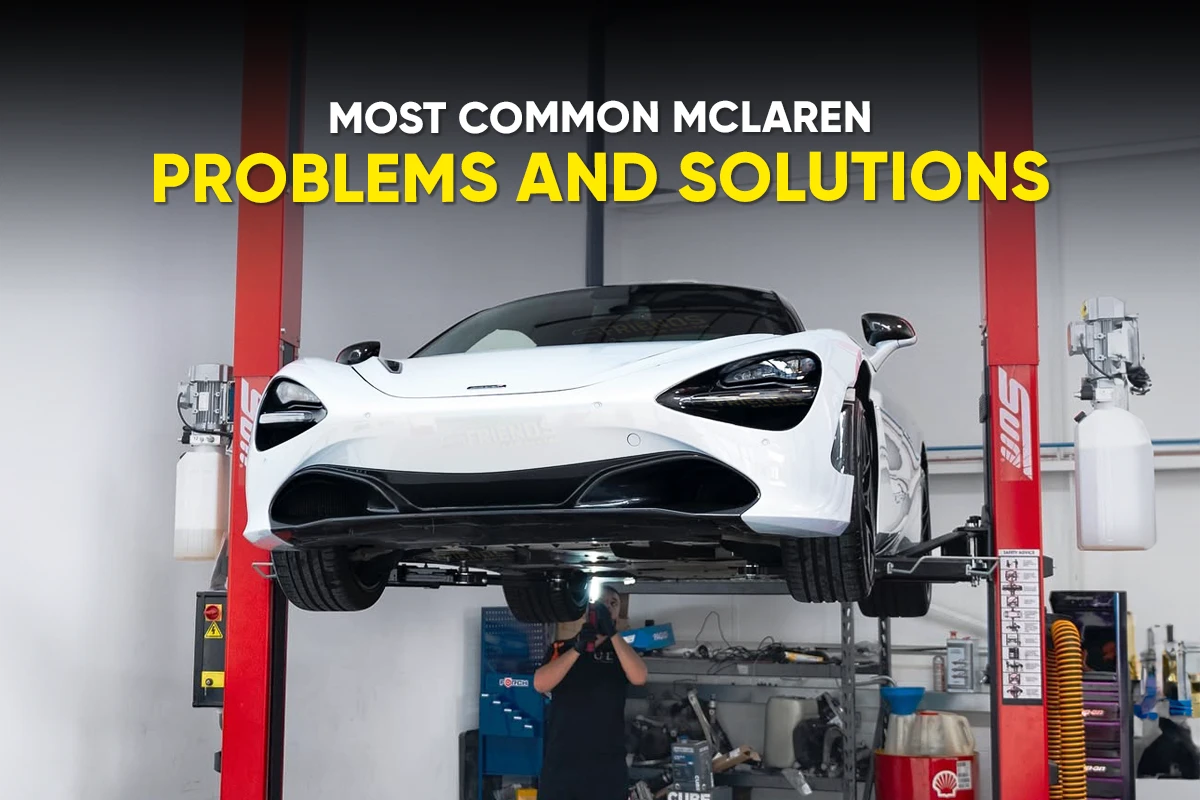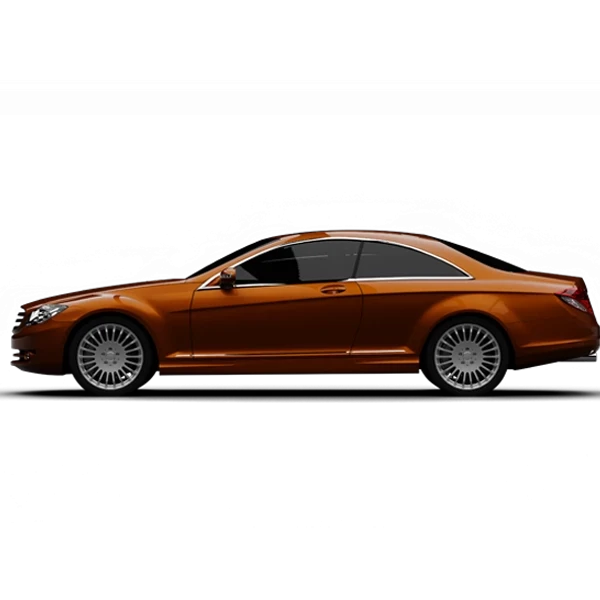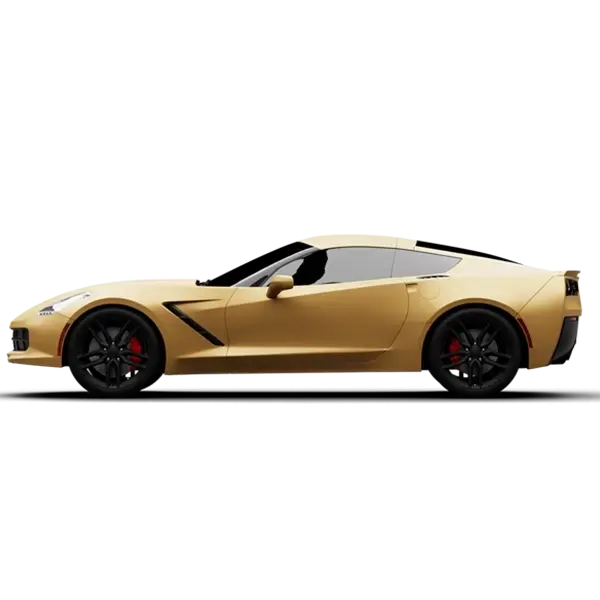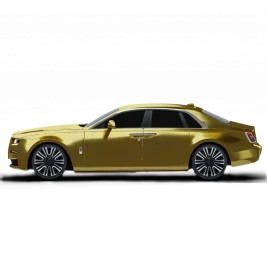15 Most Common McLaren Problems and Solutions

Looking for the most common McLaren problems and solutions? This comprehensive guide details the 15 most frequent McLaren car issues and their practical fixes, empowering current & future owners to maintain their cars with confidence.
McLaren, an icon of British engineering, has a global reputation for performance, innovation, and style. However, like any complex machine, even these meticulously built cars are not immune to issues. Understanding the existing McLaren car problems and their solutions is crucial for a hassle-free and exhilarating ownership experience.
Learn about these 15 McLaren problems to avoid unexpected setbacks on the road and ensure a seamless and confident driving experience. Dive in & stay ahead of the curve.
15 Common McLaren Issues and Fixes: Overview
To help you diagnose and resolve issues faster, check out this overview table of the 15 most common McLaren problems, affected models, costs, and key fixes:
Related Article: Most Common Volkswagen Problems and Solutions
Electrical and Infotainment Issues
1. Infotainment System Glitches
What Happens:
The McLaren's IRIS infotainment system can suffer from various electronic issues, from minor software bugs to a complete functionality loss. These glitches often manifest as an unresponsive or frozen touchscreen.
It can prevent the driver from controlling navigation, audio, and some climate functions. The system can also experience boot loops, where it continuously restarts.
Affected Models:
This is a common issue across a range of post-2015 models, including the 540C, 570S, 650S, and 720S, which share a similar IRIS infotainment platform.
Symptoms:
A completely black or blank screen.
The touchscreen becomes unresponsive to touch commands.
The system freezes or becomes very slow to respond.
Audio cutting in and out or failing to play.
Bluetooth and GPS connectivity issues.
Common Causes:
Software Bugs: Like any complex electronic system, the IRIS unit is susceptible to software glitches.
Loose Connections: Poor wiring or loose connectors behind the unit can interrupt the power supply.
Power Fluctuations: A weak or ageing 12-volt battery can cause voltage drops that interfere with the system's operation.
Hardware Failure: In some cases, the internal components of the head unit or the LCD screen itself can fail.
Impact:
Frustration and Reduced Driving Pleasure.
Loss of Essential Functions.
Costly Repairs.
Solutions:
Perform a software update at a dealer to address known bugs.
Try a system reboot by disconnecting the battery or using a specific button combination.
Replace the faulty touchscreen, wiring, or head unit if the issue is due to hardware failure.
Estimated Repair Cost:
Software Update/Reprogramming: AED 750-1,500
Head Unit/Screen Replacement: AED 7,300-14,700+
Prevention Tips:
Keep the battery healthy by using a trickle charger when the car is stored for long periods.
Ensure the car's software is kept up to date during its regular service intervals.
Address any minor electronic quirks immediately.
2. Unreliable Sensors
What Happens:
A variety of sensors in a McLaren can fail or provide inaccurate data, which can trigger a cascade of warning lights on the dashboard. These sensors are vital for monitoring everything from engine performance and wheel speed to door latches and fluid levels.
When they become unreliable, the car's ECU may put the vehicle into a limp home mode to prevent potential damage.
Affected Models:
Specific instances have been widely reported in the 570S and 720S models, particularly with door latch and wheel speed sensors.
Symptoms:
False warning lights on the dashboard, such as Check Engine, Brake System Fault, or Suspension Fault.
The vehicle unexpectedly enters a reduced power or limp home mode.
The car struggles to start, misfires, or idles roughly.
Inconsistent performance with features like tyre pressure monitoring or automatic door operation.
A rattling or buzzing noise from behind the seats in some models, which can indicate a faulty parking sensor buzzer.
Common Causes:
Wear and Tear: Sensors are delicate electronic components that can degrade over time, especially in high-stress, high-heat environments.
Damaged Wiring: Loose or damaged wiring harnesses can cause intermittent signals or a complete loss of communication from the sensor.
Moisture or Debris: Exposure to moisture, dirt, or road debris can corrupt or damage the sensor, particularly those on the exterior, like wheel speed or parking sensors.
Low Battery Voltage: A weak 12-volt battery can cause fluctuations in the electrical system, leading to false sensor readings.
Impact:
A feeling of diminished vehicle reliability and owner confidence.
The inability to drive the car at its full potential due to limp home mode.
High diagnostic and repair costs due to the complexity of the systems.
Solutions:
A professional diagnostic scan at a McLaren service centre is required to pinpoint the exact sensor that is failing.
Once identified, the faulty sensor is replaced with a new one. In some cases, a software reset or re-learn procedure is required.
If the issue is a loose connection, the wiring harness may be secured or repaired.
Check and maintain the health of the 12-volt battery to ensure a stable power supply for all electronic systems.
Estimated Repair Cost:
Sensor Part Cost: AED 750 - AED 4,000+ per sensor, depending on the type.
Labour: AED 500 - AED 1,500+ for diagnostics and replacement.
Prevention Tips:
During routine servicing, have a specialist inspect visible sensors and wiring harnesses for signs of damage or corrosion.
Proactively use a battery tender to maintain a strong and consistent charge, especially when the vehicle is not in regular use.
Minimise driving on rough roads that could dislodge or damage sensors located near the wheels or underbody.
Related Article: Most Common Jeep Problems and Solutions
3. Battery Drain
What Happens:
A common and frustrating issue for McLaren owners is battery drain, often referred to as a parasitic drain. This occurs when electronic components continue to draw a small amount of power even when the vehicle is turned off, slowly depleting the 12-volt battery.
Due to the high number of complex electronic systems in modern McLarens, this drain can be significant, leading to a dead battery if the car is left sitting for more than a few days.
Affected Models:
This is a nearly universal issue across all modern McLaren models, including the 570S, 720S, and GT, due to their complex electrical architectures.
Symptoms:
The car fails to start after being parked for an extended period.
The vehicle's start/stop system becomes inoperable.
The infotainment system and dashboard lights flicker or fail to turn on.
A clicking sound when the ignition key is turned.
Common Causes:
Parasitic Drain: Electronic control units (ECUs), alarms, and other systems may not fully go to sleep after the ignition is turned off.
Faulty Components: A short circuit or a malfunctioning component, such as an interior light or relay, can cause a constant drain.
Weak Battery: The battery itself may be nearing the end of its life (typically 3-5 years) and is no longer able to hold a full charge.
Infrequent Use: The battery is not being recharged regularly by the alternator on long drives.
Impact:
The risk of being stranded with a non-starting car.
Potential damage to the battery, which can lead to expensive replacement.
The need for frequent use of a battery tender can be inconvenient.
Solutions:
A diagnostic scan at a service centre to identify the source of the parasitic drain.
The faulty component, such as a relay or electronic module, is replaced.
The battery is tested and replaced if it is no longer holding a charge.
Software updates are applied to ensure all systems shut down correctly.
Estimated Repair Cost:
New 12V Battery: AED 1,000 - 3,500+ (prices can be higher for specialised lithium-ion batteries in some models).
Diagnosis & Labour: AED 500 - 1,500
Prevention Tips:
Always use a battery tender or trickle charger when the car is parked for more than a few days.
Check the battery health and voltage regularly, either at home or at a service centre.
Take the car on longer drives occasionally to allow the alternator to charge the battery fully.
Ensure all electronic accessories and lights are turned off before leaving the vehicle.
Suspension and Hydraulic Faults
4. Suspension System Warnings
What Happens:
Modern McLarens use a sophisticated hydraulic system known as Proactive Chassis Control (PCC) instead of traditional springs and dampers. This system dynamically adjusts pressure in the hydraulic lines to control ride height, body roll, and handling.
When a component fails or a leak occurs, the system cannot function correctly, triggering a Suspension Fault or similar warning on the dashboard and often forcing the car into a less-than-optimal ride setting.
Affected Models:
This issue is particularly relevant to models equipped with the PCC system, including the 570S, 720S, and the MP4-12C.
Symptoms:
A Suspension Fault or Proactive Chassis Control warning light on the dashboard.
Poor ride quality, with the car feeling excessively stiff or bouncy over bumps.
The car may sag to one side, especially after being parked for some time, due to a hydraulic leak.
Excessive body roll during cornering indicates the system is not providing dynamic stability.
Unusual clunking or rattling noises from the suspension.
Common Causes:
Sensor Malfunction: Suspension level sensors can fail, sending inaccurate data to the ECU and causing improper ride height adjustments.
Worn Components: Over time, bushings, ball joints, and other mechanical parts can wear out, leading to system faults.
Low Hydraulic Fluid: Neglecting to check and maintain hydraulic fluid levels can lead to pump damage and system failure.
Impact:
The car's handling, a key aspect of the McLaren experience, is significantly degraded.
Poor handling and excessive body roll can create a serious safety risk, especially at high speeds.
The hydraulic system is complex and specialised, making diagnosis and repair a costly process.
Solutions:
A diagnostic scan is necessary to pinpoint the exact cause of the fault.
Repairing any hydraulic leaks and replacing faulty components like accumulators or pumps.
Replacing worn components such as bushings or ball joints.
Topping off or replacing the hydraulic fluid and bleeding the system.
Estimated Repair Cost:
Diagnostic Check: AED 500-1,000
Hydraulic Leak Repair: AED 1,500-5,500+
Component Replacement (e.g., Accumulator): AED 7,500-15,000+
Prevention Tips:
Adhere to the manufacturer's recommended service schedule, which includes hydraulic fluid checks.
Listen for any unusual noises and address them immediately.
Avoid driving on rough roads or over large potholes that could damage suspension components or lines.
Ensure the vehicle's height is adjusted correctly when approaching speed bumps or steep driveways.
Related Article: Most Common Cadillac Problems and Solutions
5. Hydraulic Fluid Leaks
What Happens:
A key characteristic of McLaren's hydraulic suspension and braking systems is their reliance on high-pressure fluid. Over time, components such as hoses, seals, and O-rings can degrade, leading to fluid leaks.
These leaks can be external, leaving telltale puddles or drips, or internal, which are more difficult to diagnose and cause a loss of pressure within the system.
Affected Models:
Hydraulic leaks are a known issue across various models with complex hydraulic systems, including the MP4-12C, 650S, 570S, and 720S.
Symptoms:
Puddles or oily residue on the ground beneath the car.
The vehicle's ride height may sag or lower unevenly when parked.
A Suspension Fault or a low fluid level warning on the dashboard.
A decrease in braking efficiency or a spongy brake pedal.
Unusual whining or groaning noises from the hydraulic pump.
Common Causes:
Degraded Seals: O-rings and seals within the hydraulic lines and components can wear out or become brittle with age and heat.
Loose Fittings: The constant vibration and pressure of the system can cause fittings and banjo bolts to loosen over time.
Physical Damage: Road debris or improper service can damage hoses and lines, leading to leaks.
Contamination: Dirt or other contaminants in the fluid can cause internal wear and damage to components.
Impact:
Leaks can lead to a loss of braking power or stability, increasing the risk of a crash.
Diagnosing and repairing a hydraulic leak often requires specialised tools and expertise, with costs varying from minor to very expensive.
Hydraulic fluid is toxic and can cause significant environmental damage if not contained.
Solutions:
A diagnostic check to pinpoint the exact location and cause of the leak.
Replacement of the damaged seals, hoses, or components.
A complete hydraulic system flush and fluid top-off.
If the issue is part of a recall, the repair should be performed for free by a McLaren dealer.
Estimated Repair Cost:
Minor Leak (Hose/Seal Replacement): AED 1,500 - 5,500+
Major Component (e.g., Accumulator, Pump): AED 7,500 - 15,000+
Prevention Tips:
Follow the manufacturer's recommended maintenance schedule, including hydraulic fluid checks.
Check for leaks whenever the car is parked.
Avoid driving over road debris or large potholes that could damage the underbody components.
Ensure a qualified and experienced McLaren technician does any work on the hydraulic system.
6. Worn Suspension Components
What Happens:
A McLaren's suspension system, whether it is the standard coilover setup or the more complex Proactive Chassis Control (PCC) hydraulic system, is made of components that are subject to constant stress and wear.
Over time, parts like bushings, ball joints, control arms, and even the hydraulic accumulators can degrade, leading to a noticeable decline in ride quality and handling.
Affected Models:
McLarens that see frequent or aggressive suspension issues are the 570S, 720S, and the MP4-12C.
Symptoms:
A clunking, rattling, or squeaking noise when driving over bumps.
Uneven or premature tyre wear.
A spongy or loose feeling in the steering.
The vehicle feels bouncier than usual or dips during braking.
An improper ride height or the car sagging to one side.
Common Causes:
Wear and Tear: Aggressive driving, track use, and high mileage can accelerate the degradation of rubber and metal components.
Road Conditions: Hitting potholes, speed bumps, or driving on rough roads puts immense stress on the suspension system.
Improper Alignment: A misaligned suspension can cause parts to wear unevenly and prematurely.
Impact:
The car will lose its trademark precision and feel, affecting both comfort and confidence.
Worn parts can affect steering and braking, increasing the risk of an accident.
Replacing complex or multiple suspension components is a specialised and expensive job.
Solutions:
A full diagnostic inspection to identify which specific components are worn out.
Replacement of the worn bushings, ball joints, or control arms.
For hydraulic systems, replace the accumulators or other failed components.
A professional wheel alignment should be performed after any suspension component is replaced.
Estimated Repair Cost:
Minor Component Replacement (e.g., Bushings): AED 1,500 - 4,000+
Major Component (e.g., Control Arm/Accumulator): AED 7,500 - 15,000+
Prevention Tips:
Avoid driving aggressively over potholes, speed bumps, or rough surfaces.
Have any unusual noises checked out promptly by a professional.
Regularly inspect your tyres for uneven wear patterns, which can indicate a suspension issue.
Adhere to the manufacturer's recommended service schedule to ensure all components are checked and lubricated.
Related Article: Most Common Kia Problems and Solutions
7. Brake Line Recalls
What Happens:
A number of McLaren models have been subject to recalls related to their hydraulic brake lines. A significant recall in 2025 was issued for an assembly error where the rear brake lines were incorrectly routed. It caused them to connect to the wrong sides of the control module.
This could confuse the car's anti-lock braking system (ABS) and electronic stability program (ESP), potentially causing a rear wheel to lock up under extreme braking or stability control intervention. Another recall in 2021 involved a missing hole in a brake banjo bolt, which could lead to a complete loss of braking on one corner of the vehicle.
Affected Models:
The 2025 recall affects certain 2020-2025 models, including the 600LT, 720S, Artura, GT, and GTS. The 2021 recall was for specific 2019-2020 models, including the 570S, GT, 600LT, and 720S.
Symptoms:
A sudden and unexpected rear wheel lock-up, especially during hard cornering or braking.
The vehicle pulls to one side under braking.
A Brake System Fault warning light.
In the case of the 2021 recall, a noticeable loss of braking power on one side of the car.
Common Causes:
Manufacturing and Assembly Error: The most recent recall was caused by a human error during the assembly process, where the brake lines were routed incorrectly.
Faulty Parts: The earlier recall was due to a manufacturing defect in a brake banjo bolt, where a necessary fluid-flow hole was missing.
Design Flaws: While less common, some recalls are due to a design flaw that becomes apparent under specific real-world conditions.
Impact:
A braking system that does not function as intended can lead to a loss of vehicle control and an increased risk of a crash, particularly on a high-performance vehicle.
Recalls, while a sign of a company addressing a problem, can affect public confidence in the brand's quality control.
Solutions:
Owners of affected vehicles are notified by mail and should schedule an appointment with an authorised McLaren dealer.
Dealers will inspect the brake line connections and reroute them correctly as necessary.
For the earlier recall, dealers replaced the defective banjo bolt with a properly manufactured one.
All recall repairs are performed free of charge.
Estimated Repair Cost:
Inspection and Repair: Free of charge to the owner.
Prevention Tips:
Register your vehicle with the manufacturer for all official recalls and services.
Check the VIN of your car on the official NHTSA (National Highway Traffic Safety Administration) website or a similar government recall database to see if there are any open recalls.
If you are considering a pre-owned McLaren, have the dealer or a specialist confirm that all recall work has been completed.
Engine and Drivetrain Problems
8. Engine Misfires and Coil Pack Failures
What Happens:
Engine misfires occur when one or more of the cylinders fail to combust the air-fuel mixture properly. In McLarens, this is often traced back to a faulty ignition system, specifically a failing coil pack or a worn-out spark plug.
The coil pack, which is responsible for providing the high-voltage spark to the plug, can degrade over time, leading to a weak or inconsistent spark that causes the misfire.
Affected Models:
This is a common wear-and-tear issue in high-performance engines and is widely reported on the 570S and 720S models.
Symptoms:
A rough or shaky engine idle, especially when the car is stationary.
A noticeable loss of power or hesitation during acceleration.
The Check Engine light on the dashboard will illuminate, and it may flash when the misfire is actively occurring.
A decrease in fuel efficiency.
A strong smell of unburnt fuel from the exhaust.
Common Causes:
Worn Spark Plugs: Over time, the spark plugs' electrodes can widen, forcing the coil packs to work harder to bridge the gap, which leads to premature coil pack failure.
High Heat and Vibration: The extreme heat and constant vibration within a high-performance engine bay can degrade the coil packs.
Fluid Leaks: Oil or coolant leaks can get into the spark plug tubes and damage the coil packs.
General Wear and Tear: Like any electronic component, coil packs have a finite lifespan and will eventually fail.
Impact:
Misfires cause a significant drop in power and responsiveness, taking away from the driving experience.
Driving with a persistent misfire can cause unburnt fuel to damage the catalytic converter or other emissions components, which are very expensive to replace.
While a single coil pack may not be overly expensive, replacing a full set and spark plugs can be a significant cost.
Solutions:
A diagnostic scan is performed to identify the specific cylinder with the misfire (e.g., fault code P030x).
The spark plug from the affected cylinder is inspected and replaced.
The faulty coil pack is replaced, and in most cases, it is recommended to replace all of them at the same time to prevent future failures.
The technician checks for and repairs any fluid leaks that may have contributed to the issue.
Estimated Repair Cost:
Individual Coil Pack: AED 275 - 750+
Set of 8 Coil Packs: AED 2,200 - 6,000+
Spark Plugs (Set of 8): AED 300 - 600+
Labour: AED 500 - 1,500
Prevention Tips:
Adhere to the manufacturer's recommended service schedule for spark plug replacement.
Have a professional inspect the coil packs and wiring during routine maintenance.
Address any engine fluid leaks promptly to protect the ignition system.
Use high-quality replacement parts to ensure longevity and optimal performance.
Related Article: Most Common Bentley Problems and Solutions
9. Turbo Manifold Cracks
What Happens:
The exhaust manifold on a turbocharged McLaren is subjected to immense heat and pressure. Over time, the repeated heating and cooling cycles of the metal can cause it to fatigue and crack, particularly at the weld points.
These cracks can lead to an exhaust leak, which prevents the exhaust gases from reaching the turbocharger efficiently, thus reducing its performance. This issue has become a common topic among owners of certain McLaren models.
Affected Models:
This issue is most frequently reported on the 720S.
Symptoms:
A noticeable loss of power and reduced engine performance.
An unusual whistling or hissing sound, especially under acceleration, as exhaust gases leak from the crack.
A strong exhaust or burning smell in the engine bay or even inside the cabin.
The Check Engine light may illuminate on the dashboard due to the oxygen sensors detecting an exhaust leak.
Common Causes:
Extreme Heat Cycles: The constant expansion and contraction of the metal from extreme temperature changes is the primary cause of fatigue and cracking.
Manufacturing Defects: In some cases, a poor weld or a weak point in the original manifold's design can be a pre-existing condition that leads to a crack.
Engine Performance: An engine that is not running efficiently can produce excessive heat, putting additional strain on the manifold.
Vibration: The significant vibration of a high-performance engine can contribute to the stress on the manifold welds.
Impact:
A cracked manifold causes a loss of exhaust pressure, which can lead to a significant drop in turbocharger performance.
The excess heat leaking from the crack can damage surrounding engine bay components.
Inhaling exhaust fumes in the cabin is a potential health hazard, although this is rare.
Solutions:
A visual inspection of the manifold for any hairline cracks or black soot marks around the welds.
The manifold can be removed and professionally re-welded by a specialist, which is a temporary fix.
The complete replacement of the manifold with an upgraded or OEM part is often the most permanent solution.
Ensuring the engine is tuned properly to avoid running too hot.
Estimated Repair Cost:
Professional Weld Repair: AED 3,500 - 7,500+
OEM Manifold Replacement: AED 10,000 - 20,000+ (part only)
Labour: AED 2,500 - 6,000+
Prevention Tips:
Allow the car to cool down properly after aggressive driving to minimise thermal shock.
Adhere to regular maintenance schedules to ensure the engine is running efficiently.
Consider upgrading to an aftermarket manifold with a more durable material or design.
Visually inspect the manifold for any signs of soot or discolouration during service.
10. Fuel System Recalls
What Happens:
A number of McLarens have been subject to a safety recall related to their fuel systems. A significant recall in 2025 and a similar one in 2023 addressed a potential fuel leak caused by a component that could detach or a part that was not manufactured correctly.
Another, earlier recall in 2020 was for a foam pad beneath the fuel tank that could trap moisture, leading to corrosion and a potential fuel leak. These issues can be extremely serious, as a fuel leak in the presence of hot engine components significantly increases the risk of a vehicle fire.
Affected Models:
The fuel tank foam recall in 2020 affected models including the 2016-2020 720S, 2017-2019 570GT, 2019 Senna, and 2020 GT. The fuel pipe recalls in 2023 and 2025 were for the Artura, and one also included the GTS.
Symptoms:
A strong smell of fuel or gasoline in or around the vehicle.
Visible puddles or drips of fuel on the ground under the car.
An Engine System Fault warning light may appear on the dashboard.
In the case of a severe leak, a loss of engine power.
Common Causes:
Manufacturing Defect: The most common cause is a manufacturing flaw in a specific batch of parts, such as an incorrectly manufactured fuel pipe or a faulty nut that can loosen.
Design Flaw: In the 2020 recall, the issue was due to the design of a foam pad that trapped moisture and caused corrosion.
Impact:
A fuel leak near hot engine parts presents an immediate and severe risk of a vehicle fire, which could lead to serious injury or death.
A fire can completely destroy the vehicle and cause damage to surrounding property.
Solutions:
Owners of affected vehicles are notified by mail and should take their car to a dealer immediately.
Technicians will inspect the vehicle to confirm if it is part of the recall.
The specific faulty component, whether it is a fuel pipe, a fuel tank, or a foam pad, will be replaced or removed.
All recall repairs are performed free of charge to the owner.
Estimated Repair Cost:
Inspection and Repair: Free of charge.
Prevention Tips:
Register & ensure you receive all official recall and service notifications.
If you notice a fuel smell or see any signs of a leak, stop driving immediately and contact a McLaren service centre.
Always check for any open recalls on a pre-owned vehicle by using the VIN on an official government recall database.
Related Article: Most Common Mercedes-Benz Problems and Solutions
11. Coolant Leaks
What Happens:
The high-performance nature of a McLaren engine means its cooling system is under extreme pressure and heat. This can cause components like hoses, clamps, and radiators to fail, leading to a coolant leak.
A leak, even a minor one, can cause the engine to overheat, which can result in catastrophic and extremely expensive engine damage, such as a cracked cylinder head or a blown head gasket.
Affected Models:
This is a well-documented issue across various McLaren models, including the MP4-12C, 570S, and 650S.
Symptoms:
A puddle of bright-colored fluid (green, orange, or pink) under the car.
A sweet, syrupy smell coming from the engine bay or even inside the cabin.
The engine temperature gauge rises above its normal operating range.
The Low Coolant Level or Engine Overheating warning light appears on the dashboard.
Steam coming from the engine bay.
Common Causes:
Worn or Brittle Hoses: Over time, hoses can become brittle from heat and pressure, leading to cracks or splits.
Faulty Clamps: The factory hose clamps are known to be weak and can fail to maintain a tight seal, allowing fluid to leak.
Damaged Radiator: The radiator, located at the front, is vulnerable to damage from road debris.
Water Pump Failure: The seals and gaskets on the water pump can wear out, causing coolant to seep out.
Impact:
An overheated engine can lead to a blown head gasket or a cracked block, resulting in tens of thousands of dollars in repair costs.
A car that overheats cannot be driven and will leave the owner stranded.
Even a minor coolant leak can escalate into a major repair if not addressed immediately.
Solutions:
A technician will perform a pressure test on the cooling system to pinpoint the leak.
The damaged hose or faulty clamp is replaced.
If the radiator, water pump, or a major component is leaking, it will be replaced.
The cooling system is then refilled and properly bled to remove any air pockets.
Estimated Repair Cost:
Minor Leak (Hose/Clamp): AED 500 - 1,500
Major Component (Radiator/Water Pump): AED 2,500 - 6,000+
Prevention Tips:
Have a professional inspect the cooling system, especially the hoses and clamps, during routine maintenance.
Use a high-quality, manufacturer-recommended coolant at all times.
Listen for any new sounds or check for a sweet smell, which can be early indicators of a leak.
Do not ignore any low coolant level warnings.
12. Transmission Issues
What Happens:
A McLaren's Seamless Shift Gearbox (SSG) is a highly complex and sophisticated dual-clutch transmission designed for lightning-fast gear changes. However, this complexity can lead to issues, from minor software glitches to major mechanical failures.
Common problems include rough or delayed shifting, hesitation during acceleration, and in some cases, a complete failure of the gearbox itself.
Affected Models:
Transmission issues are most often reported on the MP4-12C, 570S, and 720S. It is more common in those models with higher mileage or that see frequent track use.
Symptoms:
Rough or jerky shifts, especially at low speeds or during rapid acceleration.
A delay in gear engagement after selecting Drive or Reverse.
The car may go into limp home mode, limiting speed and RPM.
A warning light for the transmission or engine appears on the dashboard.
A noticeable fluid leak from the transmission casing.
Common Causes:
Wear and Tear: The clutch pack and other internal components can wear out over time, especially with hard use.
Fluid Contamination: Dirty or low transmission fluid can cause a loss of hydraulic pressure, leading to power shifting and overheating.
Software Issues: Glitches or outdated software in the Transmission Control Module (TCM) can disrupt gear timing.
Component Failure: Faulty sensors, solenoids, or, in some cases, the main shaft bearings themselves can fail.
Impact:
The hallmark seamless shifts are replaced with lurches and delays, diminishing the car's performance.
Unpredictable gear changes can be dangerous in certain driving situations.
The cost to repair or replace a McLaren gearbox is among the most expensive of any issue.
Solutions:
A diagnostic scan is performed to identify any fault codes within the TCM.
A software update is performed to address any known glitches.
The transmission fluid is checked for level and condition, and a full fluid flush is performed if it is dirty or low.
For more serious issues, the transmission is removed, disassembled, and worn components like clutch packs or main shaft bearings are replaced.
Estimated Repair Cost:
Fluid Flush and Software Update: AED 1,000 - 3,500
Clutch Replacement: AED 10,000 - 25,000+
Transmission Rebuild/Replacement: AED 40,000 - 80,000+
Prevention Tips:
Follow the manufacturer's recommended service intervals for transmission fluid and filter changes.
Avoid aggressive launches and sudden, harsh shifts, especially when the car is cold.
Let the car warm up properly before driving hard to ensure the transmission fluid is at optimal temperature.
Do not ignore any signs of transmission hesitation and have the vehicle inspected immediately.
Related Article: Most Common Range Rover Problems and Solutions
Bodywork and Structural Issues
13. Cracked Windshields and Glass Panels
What Happens:
A common, and often frustrating, issue for McLaren owners is the susceptibility of their windshields and roof glass to cracking. Due to the vehicle's extremely rigid carbon fibre chassis and the large, thinly designed glass panels, any stress from the chassis flexing, a minor stone chip, or extreme temperature changes can cause a crack to appear, often starting from the edge and spreading.
Affected Models:
This issue is particularly prevalent on the 720S, which features a large, bubble-like glass canopy, and the 570S, due to the design of its front fascia and glass curvature.
Symptoms:
A visible crack that appears to originate from the edge of the glass, without an obvious impact point.
Spiderweb-like cracks from a stone chip that spread quickly.
A sudden cracking sound when the car is stationary or in motion.
In the case of roof glass, a crack may form over the driver's head.
Common Causes:
Chassis Rigidity: While a rigid chassis is great for performance, it means less flex is absorbed by the body and more is transferred to the glass panels.
Thermal Stress: Extreme temperature changes, such as going from a very hot day to a cold night, can cause the glass to expand and contract unevenly, leading to stress fractures.
Stone Chips: The large, low-angle windshields are highly susceptible to being hit by road debris and rocks, which can easily cause a chip that propagates into a crack.
Improper Installation: If a new windshield is not installed perfectly, it can create uneven pressure points that lead to cracking.
Impact:
A cracked windshield can weaken the structural integrity of the vehicle in a crash and can obstruct the driver's view.
Replacing the specialised glass is extremely expensive.
The recurring nature of this issue is a source of frequent complaints from owners.
Solutions:
For small chips, a resin injection can be used to prevent the crack from spreading, but this is often a temporary fix.
A full replacement of the glass is required for a stress crack or a crack that is in the driver's line of sight.
The replacement must be done by a certified McLaren technician to ensure proper fitment and to prevent future issues.
Some dealerships may cover the repair under warranty if it is a confirmed stress crack and not caused by an impact.
Estimated Repair Cost:
Minor Chip Repair: AED 500 - 1,500
Windshield Replacement: AED 15,000 - 30,000+
Roof Glass Replacement: Varies, but can be a similar price to the windshield.
Prevention Tips:
Maintain a safe following distance from other vehicles, especially large trucks, to avoid being hit by flying debris.
Do not blast cold air directly onto a hot windshield.
Consider a windshield protection film to provide an extra layer of defence against stone chips.
If you get a chip, get it repaired immediately before it has a chance to spread.
14. Paint and Trim Flaws
What Happens:
While McLaren is known for its exquisite design, some owners have reported issues with the quality of the factory paint and trim. The most significant problem is paint blistering or bubbling, which can be caused by a manufacturing defect.
The primer does not properly adhere to the aluminium or composite panels. Other common issues include loose interior trim pieces and minor exterior trim damage.
Affected Models:
This issue is primarily noted on the 570S, 600LT, and the 720S, especially in the earlier model years.
Symptoms:
Small bubbles or blisters appear in the paint, often at the edges of body panels.
The paint flaking or peeling away from the surface.
Interior trim pieces, such as those on the dashboard or door panels, become loose or rattling.
Uneven paint texture or orange peel in certain areas.
Common Causes:
Manufacturing Defects: The primary cause of paint bubbling is an issue during the painting process itself, where moisture or contaminants are trapped between the primer and the metal or composite panel.
Chassis Flex: The ultra-rigid carbon fibre chassis can transfer stress to the body panels, which may lead to paint cracking or bubbling over time.
Harsh Climate: Extreme heat and humidity in regions like the UAE can accelerate the degradation of materials and cause paint to blister.
Poor Prep Work: A lack of proper surface preparation before painting can cause the paint to fail prematurely.
Impact:
These issues detract from the vehicle's stunning appearance and can lower its resale value.
It can be frustrating to see these flaws on a high-end, expensive vehicle.
If an owner attempts a repair outside of an authorised dealer, it may void the paint warranty.
Solutions:
For paint blistering, a full panel repainting is often required. The flawed paint must be stripped down to the bare material before being re-primed and re-painted to ensure a lasting fix.
Loose interior trim pieces should be resecured or replaced by a professional.
Minor issues may be covered under the manufacturer's warranty, but owners should check the terms, as McLaren has changed its policy on paintwork "corrosion" issues in the past.
Estimated Repair Cost:
Paint Repair (per panel): AED 10,000 - 30,000+
Interior Trim Repair: AED 500 - 2,500+
Prevention Tips:
Consider a full-body Paint Protection Film (PPF) wrap to protect the paint from physical damage and UV rays.
Avoid washing the car with harsh chemicals and use the two-bucket method to prevent swirl marks and scratches.
For new buyers, a pre-purchase inspection can help identify any existing paint or trim flaws.
If a minor issue arises, have it checked by a certified technician immediately.
Related Article: Most Common BMW Problems and Solutions
15. Cracking Door Hinges
What Happens:
A defining feature of a McLaren is its dihedral doors, but this signature element has been a source of frustration for some owners. The hinges, which are responsible for the complex motion of the doors, are prone to developing stress cracks over time.
The issue has been linked to a design flaw and is a common complaint among owners, as it can compromise the door's function and the overall structural integrity of the car.
Affected Models:
This problem is widely reported on the Sports Series, including the 540C, 570S, and 570GT.
Symptoms:
A visible crack on the hinge itself, often near a weld point or a bolt hole.
A loud creaking or clicking noise when opening or closing the door.
The door may feel loose or exhibit excessive play when fully opened.
The door's alignment may be affected, causing it to catch on other body panels.
Common Causes:
Design Flaw: The hinges, particularly on the Sports Series, were not engineered to handle the long-term stress of the large, heavy doors, leading to premature failure.
Chassis Flex: Despite the stiff carbon fibre tub, the movement and vibrations transferred through the chassis can put additional stress on the hinge's weak points.
Physical Damage: Slamming the doors or forcing them open or closed can exacerbate the problem.
Impact:
While not an immediate safety hazard in a crash, a completely failed hinge could cause a door to detach, presenting a serious risk.
A cracked hinge detracts from the car's aesthetic value and makes a simple act like opening the door feel concerning.
The repair requires specialised parts and labour, making it a costly fix.
Solutions:
A diagnostic check of the door hinges is performed by a professional to confirm the presence of a crack.
The entire hinge assembly is replaced with a new, and sometimes updated, part.
McLaren has occasionally offered goodwill gestures to out-of-warranty cars with this issue, but it is not guaranteed.
Estimated Repair Cost:
Door Hinge Replacement (per side): AED 7,500 - 10,000
Labour: AED 1,500 - 3,000+
Prevention Tips:
Do not force the doors open or closed.
Get the creaking or unusual noises from the hinges fixed immediately.
Avoid leaving the doors fully open for extended periods, as this can put unnecessary stress on the hinges.
Consider an independent specialist who may have a more durable aftermarket solution.
Final Thoughts
In the world of high-performance supercars, knowledge isn't just power—it's the key to preserving the exhilarating rush of the open road. Your McLaren is a masterpiece of British engineering, a symphony of advanced electronics, hydraulics, and a twin-turbocharged heart.
But as this guide has shown, even a masterpiece has its quirks. From the digital dilemmas of the infotainment system to the precise demands of its hydraulic suspension. Mastering your machine is about more than just knowing how to drive it; it’s about understanding its every nuance.
By taking command of this information, you elevate your ownership experience from a mere indulgence to an act of preservation. A proactive approach is the ultimate way to honour your McLaren’s legacy.
Don’t forget to share your experiences and insights in the comments below. Help us build a community of knowledgeable owners who truly understand what it means to live the supercar life in the UAE.
Written by: FriendsCarRental
Published at: Sun, Oct 19, 2025 3:55 PM
Leave a Reply
Your email address will not be published. Required fields are marked *
Car Rental in Dubai
AED 2500
DAY
AED 0
MONTH
-
 SUV
SUV -
 4 Doors
4 Doors -
 5 Seats
5 Seats
- 1 Day Rental Available
- Deposit: Not Required
- Insurance Included
AED 5500
DAY
AED 0
MONTH
-
 Sports
Sports -
 2 Doors
2 Doors -
 2 Seats
2 Seats
- 1 Day Rental Available
- Deposit: Not Required
- Insurance Included
AED 1200
DAY
AED 0
MONTH
-
 SUV
SUV -
 4 Doors
4 Doors -
 5 Seats
5 Seats
- 1 Day Rental Available
- Deposit: Not Required
- Insurance Included
AED 1600
DAY
AED 0
MONTH
-
 SUV
SUV -
 4 Doors
4 Doors -
 5 Seats
5 Seats
- 1 Day Rental Available
- Deposit: Not Required
- Insurance Included
AED 1500
DAY
AED 28500
MONTH
-
 SUV
SUV -
 4 Doors
4 Doors -
 5 Seats
5 Seats
- 1 Day Rental Available
- Deposit: Not Required
- Insurance Included

 عربي
عربي
 English
English
 Français
Français
 Русский
Русский
 中国人
中国人
 Nederlands
Nederlands
 Española
Española
 Türkçe
Türkçe
 Italiana
Italiana














































